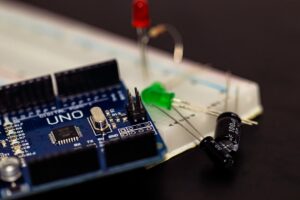Backpropagation is a fundamental algorithm used in training artificial neural networks, enabling them to learn from data by adjusting their weights based on the error of their predictions. At its core, backpropagation is an application of the chain rule from calculus, allowing the efficient computation of gradients for each weight in the network. This process begins with a forward pass, where input data is fed through the network to generate an output.
The output is then compared to the actual target values, and a loss function quantifies the difference between the predicted and actual values. This loss serves as a guide for how much each weight in the network should be adjusted. The essence of backpropagation lies in its ability to propagate the error backward through the network.
By calculating the gradient of the loss function with respect to each weight, backpropagation determines how to minimize the loss by updating the weights in the opposite direction of the gradient. This is typically done using an optimization algorithm such as stochastic gradient descent (SGD). The efficiency of backpropagation allows neural networks to learn complex patterns in data, making it a cornerstone of modern machine learning and deep learning applications.
Key Takeaways
- Backpropagation is a fundamental concept in training neural networks, involving the calculation of gradients to update the network’s weights.
- Implementing backpropagation in neural networks requires understanding the chain rule and using it to calculate the gradients of the loss function with respect to the network’s parameters.
- Optimizing backpropagation for efficient training involves techniques such as batch normalization, weight initialization, and learning rate scheduling.
- Common challenges in backpropagation include vanishing gradients, exploding gradients, and overfitting, which can be addressed through techniques like gradient clipping and regularization.
- Fine-tuning backpropagation for specific neural network architectures involves adjusting the network’s structure, activation functions, and loss functions to improve performance for specific tasks.
Implementing Backpropagation in Neural Networks
Implementing backpropagation involves several key steps that must be executed systematically to ensure that a neural network learns effectively. Initially, one must define the architecture of the neural network, which includes determining the number of layers, the number of neurons in each layer, and the activation functions used.
Once the architecture is established, the next step is to initialize the weights and biases of the network, typically using small random values to break symmetry. The forward pass follows, where input data is processed through each layer, applying weights and activation functions to produce an output. After obtaining the output, the loss function is computed to evaluate how well the network performed.
The choice of loss function can vary based on the task; for instance, mean squared error is often used for regression tasks, while cross-entropy loss is preferred for classification problems. After calculating the loss, backpropagation begins with the computation of gradients. This involves calculating how much each weight contributed to the overall error by applying the chain rule iteratively from the output layer back to the input layer.
Each weight’s gradient is then used to update its value according to a specified learning rate. This process is repeated for multiple epochs over the training dataset until convergence is achieved or performance plateaus.
Optimizing Backpropagation for Efficient Training

Optimizing backpropagation is crucial for enhancing the training speed and performance of neural networks. One common approach is to adjust the learning rate dynamically during training. Techniques such as learning rate scheduling or adaptive learning rates (e.g., Adam optimizer) can help prevent overshooting minima in the loss landscape and improve convergence rates.
A well-tuned learning rate can significantly reduce training time while ensuring that the model does not oscillate or diverge. Another optimization technique involves mini-batch gradient descent, which strikes a balance between stochastic gradient descent and full-batch gradient descent. By dividing the training dataset into smaller batches, mini-batch gradient descent allows for more frequent updates to weights while still benefiting from some level of statistical averaging.
This method not only speeds up training but also introduces noise into the optimization process, which can help escape local minima and lead to better generalization on unseen data. Regularization techniques also play a vital role in optimizing backpropagation. Methods such as L1 and L2 regularization add penalties to the loss function based on the magnitude of weights, discouraging overly complex models that may overfit training data.
Dropout is another popular regularization technique where random neurons are temporarily removed during training, forcing the network to learn more robust features that are less reliant on specific neurons.
Overcoming Common Challenges in Backpropagation
| Challenges | Potential Solutions |
|---|---|
| Vanishing Gradients | Use activation functions like ReLU, Leaky ReLU, or ELU to mitigate vanishing gradients. |
| Exploding Gradients | Apply gradient clipping or use normalization techniques like batch normalization or layer normalization. |
| Overfitting | Implement regularization techniques such as L1 or L2 regularization, dropout, or early stopping. |
| Convergence Speed | Utilize adaptive learning rate methods like Adam, RMSprop, or learning rate schedules. |
Despite its effectiveness, backpropagation can encounter several challenges that may hinder successful training of neural networks. One significant issue is vanishing gradients, particularly in deep networks with many layers. As gradients are propagated backward through multiple layers, they can diminish exponentially, leading to minimal updates for weights in earlier layers.
This phenomenon can stall learning and prevent deeper layers from effectively capturing complex patterns in data. To address vanishing gradients, various strategies have been developed. One approach is to use activation functions that mitigate this issue, such as ReLU and its variants (Leaky ReLU, Parametric ReLU).
These functions maintain a positive gradient for positive inputs, allowing gradients to flow more effectively through deep networks. Additionally, techniques like batch normalization can stabilize learning by normalizing layer inputs, which helps maintain healthy gradient magnitudes throughout training. Another challenge is overfitting, where a model learns noise in the training data rather than generalizable patterns.
This often occurs when a model is too complex relative to the amount of training data available. To combat overfitting, practitioners can employ strategies such as early stopping—monitoring validation loss during training and halting when performance begins to degrade—or using more extensive datasets through data augmentation techniques that artificially expand training samples.
Fine-tuning Backpropagation for Specific Neural Network Architectures
Different neural network architectures may require tailored approaches to backpropagation to maximize their effectiveness. For instance, convolutional neural networks (CNNs), commonly used in image processing tasks, leverage local connectivity and shared weights through convolutional layers. The backpropagation process in CNNs involves computing gradients not only for fully connected layers but also for convolutional filters and pooling layers.
This necessitates specialized implementations that account for these unique structures. Recurrent neural networks (RNNs), which are designed for sequential data such as time series or natural language processing tasks, face additional complexities due to their temporal dependencies. Backpropagation through time (BPTT) is an extension of standard backpropagation used in RNNs that unfolds the network across time steps and computes gradients at each step.
This method allows RNNs to learn from sequences effectively but can also suffer from vanishing gradients if not managed properly. Fine-tuning backpropagation for architectures like transformers—widely used in natural language processing—requires understanding their attention mechanisms and multi-head self-attention layers. The gradients must be computed not only for traditional feedforward connections but also for attention weights that dictate how different parts of input sequences interact with one another.
This complexity necessitates careful implementation to ensure efficient training while maintaining model performance.
Utilizing Backpropagation for Deep Learning

Overcoming Computational Challenges
In practice, deep learning models often require extensive computational resources due to their complexity and size. To address this, techniques such as transfer learning have emerged as effective strategies for utilizing pre-trained models on large datasets and fine-tuning them on specific tasks with limited data. Backpropagation plays a vital role in this process by adjusting only certain layers while keeping others fixed, allowing practitioners to leverage existing knowledge while adapting models to new challenges.
Hardware Advancements
Advancements in hardware—such as GPUs and TPUs—have significantly accelerated backpropagation processes in deep learning frameworks like TensorFlow and PyTorch. These frameworks provide optimized implementations of backpropagation algorithms that take advantage of parallel processing capabilities, enabling researchers and developers to train deep networks more efficiently than ever before.
Efficient Training of Deep Networks
The combination of backpropagation and hardware advancements has enabled the efficient training of deep networks. This has opened up new possibilities for researchers and developers to explore complex problems and develop innovative solutions.
Exploring Advanced Techniques in Backpropagation
As research progresses in machine learning and artificial intelligence, advanced techniques related to backpropagation continue to emerge. One notable area is meta-learning or “learning to learn,” where models are trained on a variety of tasks so they can quickly adapt to new tasks with minimal data. Backpropagation plays a crucial role here by allowing models to adjust their parameters based on experiences from previous tasks efficiently.
Another advanced technique involves using second-order optimization methods like Newton’s method or quasi-Newton methods (e.g., L-BFGS) that utilize second derivatives (Hessian matrix) for more accurate weight updates compared to first-order methods like SGD. While these methods can converge faster under certain conditions, they are computationally intensive and often impractical for large-scale neural networks due to their complexity. Additionally, researchers are exploring alternative approaches such as evolutionary algorithms and reinforcement learning techniques that may complement or even replace traditional backpropagation methods in specific contexts.
These approaches can optimize neural networks by simulating evolutionary processes or learning optimal policies through trial-and-error interactions with environments.
Future Developments in Backpropagation and Neural Network Training
The future of backpropagation and neural network training holds exciting possibilities as researchers continue to innovate and refine existing methodologies. One area of focus is improving efficiency through techniques like sparse training or pruning, where unnecessary weights are removed from trained models without significantly impacting performance. This could lead to lighter models that require less computational power while maintaining accuracy.
Another promising direction involves integrating unsupervised or semi-supervised learning techniques with backpropagation methods. By leveraging unlabelled data alongside labelled datasets, models could learn more robust representations without requiring extensive labelled datasets—a significant challenge in many real-world applications. Furthermore, advancements in quantum computing may revolutionize how backpropagation is implemented by enabling faster computations through quantum algorithms.
As quantum hardware matures, it could provide new avenues for optimizing neural network training processes beyond classical limitations. In summary, while backpropagation remains a cornerstone of neural network training today, ongoing research and technological advancements promise to enhance its capabilities further and address existing challenges within this dynamic field.
If you are interested in exploring the philosophical underpinnings of backpropagation in neural networks, you may find this article on the philosophies of Tagore and Radhakrishnan relevant. It delves into humanism, intuition, and man’s destiny, which can provide a deeper understanding of the principles behind backpropagation. Additionally, for a broader perspective on the role of mathematics in education and society, you may want to check out this article discussing mathematics as an intellectual property versus a humanistic discipline. These articles can offer valuable insights into the context and implications of backpropagation in the field of artificial intelligence.





















+ There are no comments
Add yours